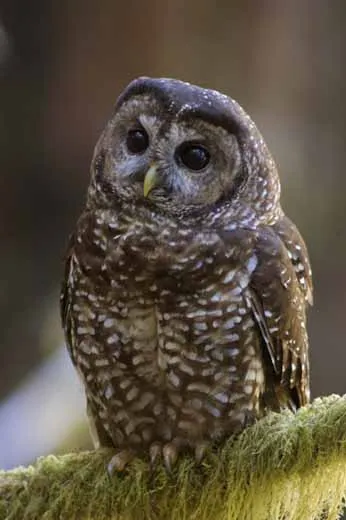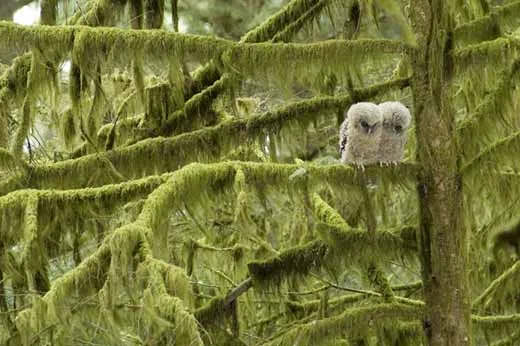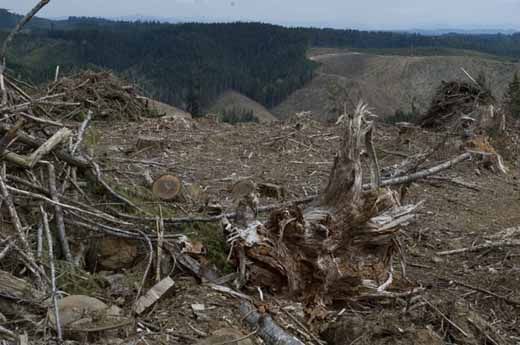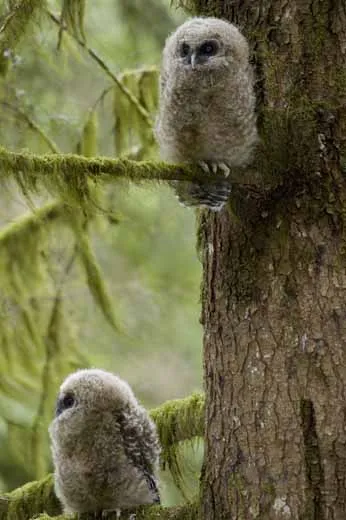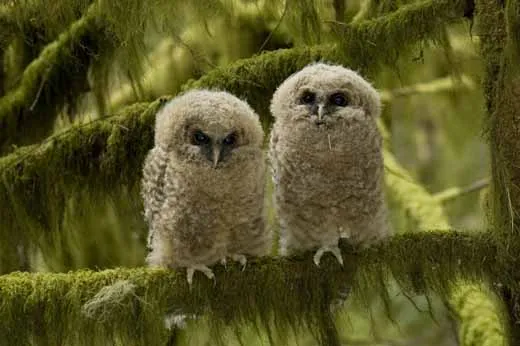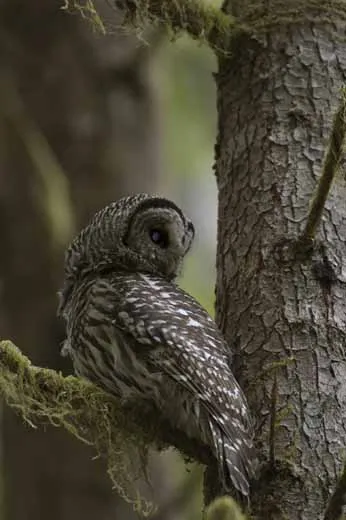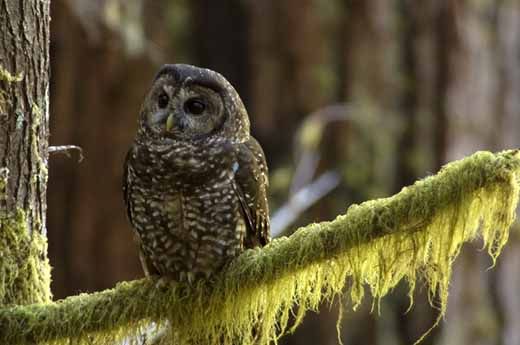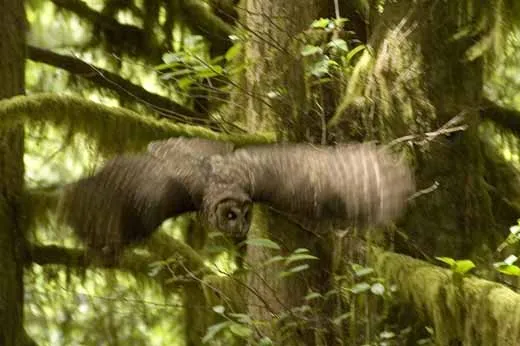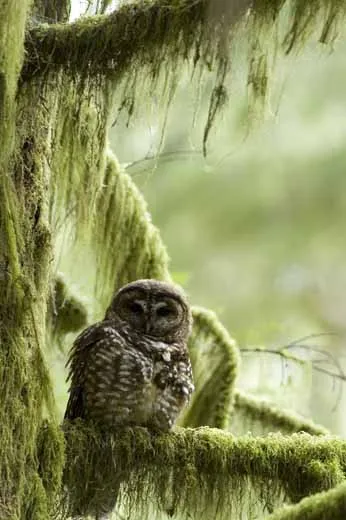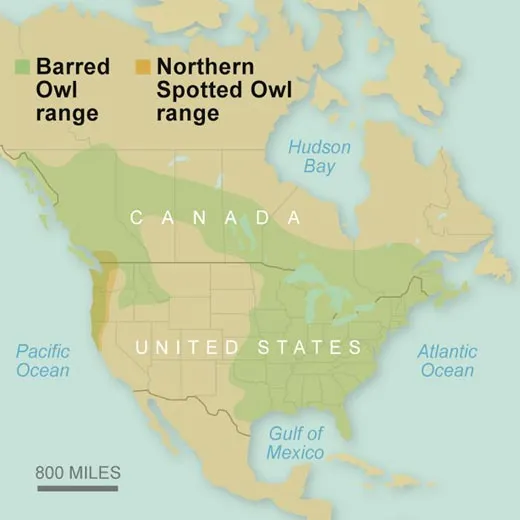The Spotted Owl’s New Nemesis
An battle between environmentalists and loggers left much of the owl’s habitat protected. Now the spotted owl faces a new threat
/https://tf-cmsv2-smithsonianmag-media.s3.amazonaws.com/filer/Three-week-old-spotted-owl-hatchlings-631.jpg)
Eric Forsman tramped across the spongy ground with one ear tipped to the tangled branches above. We were circling an isolated Douglas fir and cedar stand near Mary's Peak, the highest point in Oregon's Coast Range, scouring the trees for a puff of tobacco-hued feathers. I had come to see one of the planet's most-studied birds—the Northern spotted owl—with the man who brought the animal to the world's attention.
Forsman stopped. "You hear it?" he asked. I didn't. Above the twitter of winter wrens I caught only the plunk of a creek running through hollow logs. Then Forsman nodded at a scraggly hemlock. Twenty feet off the ground, a cantaloupe-size spotted owl stared back at us. "It's the male," he whispered.
Before I could speak, Forsman was gone. The 61-year-old U.S. Forest Service biologist zipped down one fern-slippery hill and up another. For years, he'd explained, this bird and its mate pumped out babies like fertile field mice, producing more offspring than other spotted owls in the range. Forsman wanted to reach their nest to see if this year's eggs had hatched—and survived.
Every chick counts, because spotted owls are vanishing faster than ever. Nearly 20 years after Forsman's research helped the federal government boot loggers off millions of acres to save the threatened owls, nature has thrown the birds a curveball. A bigger, meaner bird—the barred owl—now drives spotted owls from their turf. Some scientists and wildlife managers have called for arming crews with decoys, shotguns and recorded bird songs in an experimental effort to lure barred owls from the trees and kill them.
To Forsman and other biologists, the bizarre turn is not a refutation of past decisions but a sign of the volatility to come for endangered species in an increasingly erratic world. As climate chaos disrupts migration patterns, wind, weather, vegetation and river flows, unexpected conflicts will arise between species, confounding efforts to halt or slow extinctions. If the spotted owl is any guide, such conflicts could come on quickly, upend the way we save rare plants and animals, and create pressure to act before the science is clear. For spotted owls "we kind of put the blinders on and tried to only manage habitat, hoping things wouldn't get worse," Forsman said. "But over time the barred owl's influence became impossible to ignore."
When I finally hauled myself up to Forsman, yanking on roots for balance, I found him squatting on the ground looking at the curious female spotted owl. The bird, perched unblinking on a low branch not ten feet away, hooted a rising scale as if whistling through a slide flute. Her partner fluttered in and landed on a nearby branch.
Both creatures stared intently at Forsman, who absently picked at a clump of fur and rodent bones—an owl pellet regurgitated by one of the birds. Moments later the female launched herself to a tree crevice some 40 feet off the ground. Her head bobbed as she picked at her nest. Over the next hour, we looked through binoculars hoping to spy a chick.
It was here, not half a mile away, above a trickle of runoff called Greasy Creek, that Forsman saw his first spotted owl nest in 1970. He had grown up chasing great horned owls in the woods outside an old strawberry farm near Eugene, and as an undergraduate at Oregon State University he prowled the forests in search of rare breeds. One day he shimmied up a tree and poked his head inside a crack. He escaped with brutal talon marks on his cheek and one of the earliest recorded glimpses of a spotted owl nest. He also scooped up a sick chick—its eyes were crusted shut—planning to nurse it back to health and return it to its nest. When he came back, though, the adult birds had vanished, so Forsman raised the baby bird himself. It lived in a cage outside his home for 31 years.
Drawn by the romance of this obscure creature that hides in dark woods, Forsman became a spotted owl expert. He was the first to note that the birds nest primarily in the cavities of ancient trees or in the broken-limbed canopies of old-growth forests, where they feast on wood rats, red tree voles, flying squirrels and deer mice. Logging of the Pacific Northwest's conifers accelerated during the post-World War II housing boom and continued afterward. Forsman and a colleague, biologist Richard Reynolds, warned Congress and the U.S. Forest Service that shrinking forests threatened the owl's existence. They sent one of their first letters, to then-Senator Bob Packwood of Oregon, in 1973.
The owl population crash finally began in the 1980s, about the time the environmental movement was finding its footing. In an effort to save what remained of the old-growth forests the birds needed to survive, radical environmentalists pounded steel or ceramic spikes into firs, which threatened to destroy chain saws and mill blades. They donned tree costumes to attract attention to their cause and crawled into tree platforms to disrupt logging. Counter-protests erupted. In angry mill towns, café owners provocatively served "spotted owl soup" and shops sold T-shirts and bumper stickers ("Save a Logger, Eat an Owl"). There were lawsuits, and, in 1990, the Northern subspecies of spotted owl came under the Endangered Species Act (two subspecies in other parts of the country were not affected). A sweeping federal court ruling in 1991 closed much of the Northwest woods to logging. By the end of the century, timber harvest on 24 million acres of federal land had dropped 90 percent from its heyday. The spotted owl crystallized the power of the species-protection law. No threatened animal has done more to change how we use land.
Yet the protection would prove insufficient. Throughout their range, from Canada to California, Northern spotted owls are disappearing three times faster than biologists had feared. Populations in parts of Washington are half what they were in the 1980s. So few birds remain in British Columbia that the provincial government plans to cage the last 16 known wild spotted owls and try to breed them in captivity. "In certain parts of its range," says Dominick DellaSala, chief scientist of the National Center for Conservation Science & Policy, "the spotted owl is circling the drain."
Barred Owls, meanwhile, are thriving. Farther south in the Oregon woods, I crunched through dead leaves behind Robert Anthony, a U.S. Geological Survey biologist, and David Wiens, a wildlife science graduate student at Oregon State. Wiens swept an antenna through the forest, weaving it in and out of snarled branches below overcast skies. Within minutes he pulled up short. The source of his signal looked down from upslope—a barred owl. He'd outfitted the bird with a transmitter the year before.
Half a dozen years earlier, Wiens whispered, spotted owls occupied this patch of forest. "Then barred owls were found and they've kind of taken over," he said. Spotted owls have not been seen here since.
Most of the evidence that barred owls are harming spotted owls is circumstantial; that's why Wiens and other researchers traipse the woods daily, studying how the two species fight for space and food. Still, the trend is clear. Rocky Gutiérrez, a University of Minnesota wildlife biologist, wrote in 2006 that "despite the paucity of information, many biologists now feel that the barred owl is the most serious current threat to the spotted owl."
Both barred and spotted owls, along with great gray owls and rufous-legged owls, belong to the genus Strix, medium-sized birds that lack the hornlike tufts of ear feathers common to many other owls. They are so closely related that they sometimes crossbreed, blurring species boundaries and diluting spotted owl genes. More often, though, when barred owls move in, spotted owls just disappear.
Where spotted owls are finicky eaters, barred owls consume almost anything, including spotted owls. Barred owls, typically 20 percent larger than their rivals, may take over spotted owl nests or slam into their breasts like feathery missiles. "The barred owl is the new bully on the block," DellaSala says. A few years ago, a naturalist in Redwood National Park observed the aftermath of a murderous encounter: a barred owl with a tuft of mottled feathers clinging to its talons flapping near a decapitated, partially gnawed spotted owl. When scientists dissected the spotted owl's body, they saw that it had been sliced and perforated, as if by talons.
No one knows precisely why the bigger birds came West. Barred owls originally ranged from Florida to Maine and west to the treeless expanse of the Great Plains. Sometime in the 20th century, the birds skipped west, possibly across Canada. Perhaps they followed settlers who suppressed fire, allowing trees to grow and providing nesting pockets. Some scientists blame the influx of barred owls on climate change; a few suggest it's a natural range expansion. In 1990, barred owls in a forest west of Corvallis, Oregon, occupied less than 2 percent of spotted owl sites; today, barred owls nest in 50 percent of them. Barred owls have yet to saturate Oregon and California, but in a part of Washington's Gifford Pinchot National Forest set aside for the smaller bird, barred owl nests outnumber spotted owl sites by a third. When barred owls invaded the Olympic Peninsula, spotted owls moved to higher, steeper forests with smaller trees and less food—"like moving from the Sheraton to some dive motel," DellaSala says.
To count owls, which are nocturnal and hard to find, researchers do a lot of hooting; when the birds call back, biologists plunge into the forest toward the sound, usually at a sprint, stopping every so often to call out and listen again, the hoots echoing back and forth through the woods until human and bird wind up face to face. For spotted owls, the sound is vaguely like a cross between a muted rooster call and a French horn: "hoot-hootoot-hoo." For barred owls, the tone is similar but the call is longer and patterned differently: "hoot-hoot-wahoot, hoot-hoot wahoo." For a time, some researchers hoped that spotted owls were just clamming up around barred owls and there were actually more than they thought. But that hope has largely faded. "There's evidence that spotted owls decrease vocalizations in response to barred owls," says Forest Service biologist Stan Sovern. "But honestly, I don't think spotted owls can just be silent somewhere and stay there. Part of their natural history is calling back and forth to one another."
Predictably, perhaps, loggers, timber companies and politicians seized on the barred owls as evidence that logging wasn't to blame for the spotted owl's plight. They have called for a return of chain saws to federal woods, so far without success. But years of efforts by the Bush administration to jump-start logging in the Pacific Northwest remain the subject of courtroom skirmishes between the timber industry, conservation groups and several federal agencies.
Yet far from saying that the logging restrictions were a mistake, owl biologists largely insist that more forests must be spared, especially since heavy logging continues on state and private land. As Wiens and I peered across a timbered ridge, craning to see the barred owl's nest, Anthony said, "If you start cutting habitat for either bird, you just increase competitive pressure."
When barred owls started moving into spotted owl habitat, the U.S. Fish and Wildlife Service initially proposed killing hundreds of the invaders. After an outcry from scientists and the public, wildlife managers instead plan to launch smaller studies to see if culling barred owls prompts the spotted birds to return. Even proponents of the approach acknowledge that the idea raises a thorny question: When is it appropriate to kill one species to help another?
Scientists and wildlife officials have taken extreme measures when species collide. Government marksmen on the Columbia River below Bonneville Dam shoot rubber bullets and explode firecrackers to drive away sea lions fattening up on endangered salmon. Downriver, the U.S. Army Corps of Engineers has been relocating a colony of Caspian terns, which feast on endangered salmon and steelhead. In 2005, government contractors shot Arctic foxes outside Barrow, Alaska, to protect ground-nesting shorebirds. Not long ago, government-sponsored hunters in central Washington killed coyotes that preyed on the world's last remaining pygmy rabbits.
A scientist in California collecting museum specimens recently shot a few barred owls near abandoned spotted owl nests. Two weeks later, a spotted owl returned to the area. "He flew up, sat in the branch and was sitting there, like, ‘Where's my mouse?'" says Kent Livezey, a wildlife biologist with the Fish and Wildlife Service and a member of the scientific work group trying to design barred owl control experiments. "He'd been hanging around."
Joe Buchanan, a biologist at Washington's Department of Fish and Wildlife, advocates targeted hunts if the evidence indicates that culling barred owls creates havens for spotted owls. But he acknowledges there are limits: "We can't push barred owls back to the Mississippi River."
Forsman supports shooting barred owls only to determine a cause-effect relationship between the two birds. Anything beyond that strikes him as impractical. "You could shoot barred owls until you're blue in the face," he said. "But unless you're willing to do it forever, it's just not going to work."
It would be several weeks before Forsman could tell for certain, to his delight, that the pair of spotted owls near Greasy Creek had again defied the odds and reared two young hatchlings. Yet Forsman isn't sanguine about the spotted owl's chances, particularly in northern areas like the Olympic Peninsula, where the barred owl concentration is high. "Whether barred owls will completely replace spotted owls...it's not clear," he says. "I would say the most optimistic view is that at some point we'll end up with a population that's largely barred owls, with a few scattered pairs of spotted owls."
Yet after nearly four decades of tracking these birds, Forsman won't discount nature's capacity to surprise again. "No one really knows how this will play out in the long run," he says. Some elements of life in these ancient moss-draped forests remain shrouded in mystery.
Craig Welch lives in Seattle and is writing a book about wildlife thieves.
Gary Braasch's most recent book is Earth Under Fire: How Global Warming is Changing the World.
